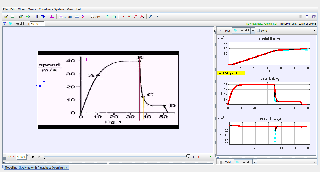
Notes for teachers and learners who would like to use this TRZ file.
A. The fy is parameterize for the ease of modelling.
m = mass of human body
A_h = surface area of human body
A_p = surface area of parachute
g at 2000 m height
d = density of air
Cd = drag coefficient of human body
Cd2 = drag coefficient of parachute
g2 = g near surface of Earth
T – time for parachute opening
Model A(Red): Parachute opens slowly over T seconds
Fy function:
if(t<35,m*g-A_h*0.5*d*Cd*vy^2,if(t<35+T,m*g-0.5*d*Cd2*(A_h+(t-35)/T*A_p)*vy^2,if(t<55,m*g-0.5*d*Cd2*(A_h+A_p)*vy^2,if(vy>0,-m*g,0))))
Model B(Blue): Parachute opens fully immediately
Fy function:
if(t<35,m*g-A_h*0.5*d*Cd*vy^2,if(t<55,m*g-0.5*d*Cd2*A_p*vy^2,if(vy>0,-m*g,0)))
Comparisons:
Model B, where the parachutes opens immediately, shows a steeper deceleration due to large upward air resistance, compared to Model A, the parachutes opens in 3 seconds.
Model B has a deceleration of 17g, while Model A’s deceleration is 3.1g.
I think it is a bad idea to open the parachute immediate while the parachutist is falling at 40 m/s. In real life, according to a Discovery Education Channel video (https://www.youtube.com/watch?v=ur40O6nQHsw), the parachute takes about 2-3 seconds to open fully.
Ideas for teaching and demonstration:
Adjusting the parameters and compare the velocity-time graph and acceleration-time graph.
Related Singapore O Level Physics question: 5058/2010/P1 Q3.
Author: Tan Kim Kia
Contact: kimkia.family@gmail.com | tan_kim_kia@moe.edu.sg
More information at: http://tankimkia.blogspot.sg/2015/09/the-physics-of-skydiving-explain-with.html